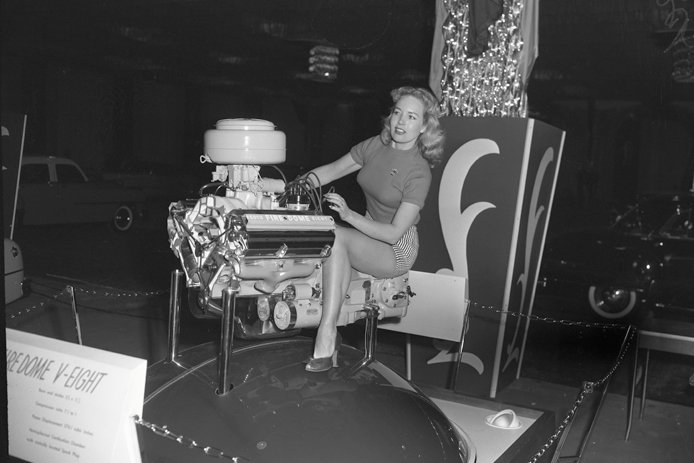The match that lit the “horsepower wars” on fire in the early 1950s through to the oil crisis of the 1970s was struck by the Chrysler Corporation, almost by accident. The company had developed a WWII fighter plane engine which had been rigorously tested and proven. However, the engine never went into production and was scrapped. That “failure” would lead to one of the most iconic engines in all of hot-rodding — the Hemi.
Chrysler engineers adapted the concepts they used for their wartime engine in the FirePower line of V8s powering the 1951 Chryslers. These were the first “Hemi” engines for mass production in America. By the ’60s, Chrysler had popularized (and trademarked) the term “Hemi,” which was shorthand stemming from the hemispherical combustion chamber design.
After the success of Chrysler’s FirePower V8 in 1951, DeSoto rolled into the LA International Auto Show in 1952 with a big display on the new FireDome V8, its first Hemi variant. The 276 cubic-inch engine produced 160 horsepower.
A cylinder head with a hemispherical combustion chamber has excellent airflow due to its design. While there have been several attempts at multi-valve configurations, the hemispherical chamber as we’re discussing here has only two large valves per cylinder. The intake and exhaust valves sit on opposite sides of the chamber, creating a “crossflow” head design.

Other automakers had hemispherical chamber heads, including Aston Martin with its DOHC V8. This engine started production in the 1960s and ran through to the 1980s. The 5.3-liter engine made 315 horsepower. Later versions used Bosch fuel injection.
Hemi Is More Than Just A Name
Most muscle car enthusiasts today associate anything hemispherical (not just the trademarked “Hemi”) with Mopar. But Chrysler wasn’t the only auto manufacturer to use a hemispherical cylinder head. In the early part of the 20th century, many automakers toyed with hemispherical designs, including Alfa Romeo, Aston Martin, Porsche, Jaguar, Ford, Toyota, and others. Chrysler, however, perfected the Hemi and used it to boost sales.
Aside from the WWll big Hemi fighter plane engine, nearly all folks consider the early ’50s 331 Chrysler FirePower to kick off the true OEM Hemi engines. — Mike Lozano, Egge Machine
The original FirePower Hemi engine is sometimes referred to as the Type-1. The Chrysler Corp. followed that up with DeSoto’s FireDome and Dodge’s Red Ram, referred to as Type-2 and…
Click Here to Read the Full Original Article at DragzineDragzine…

